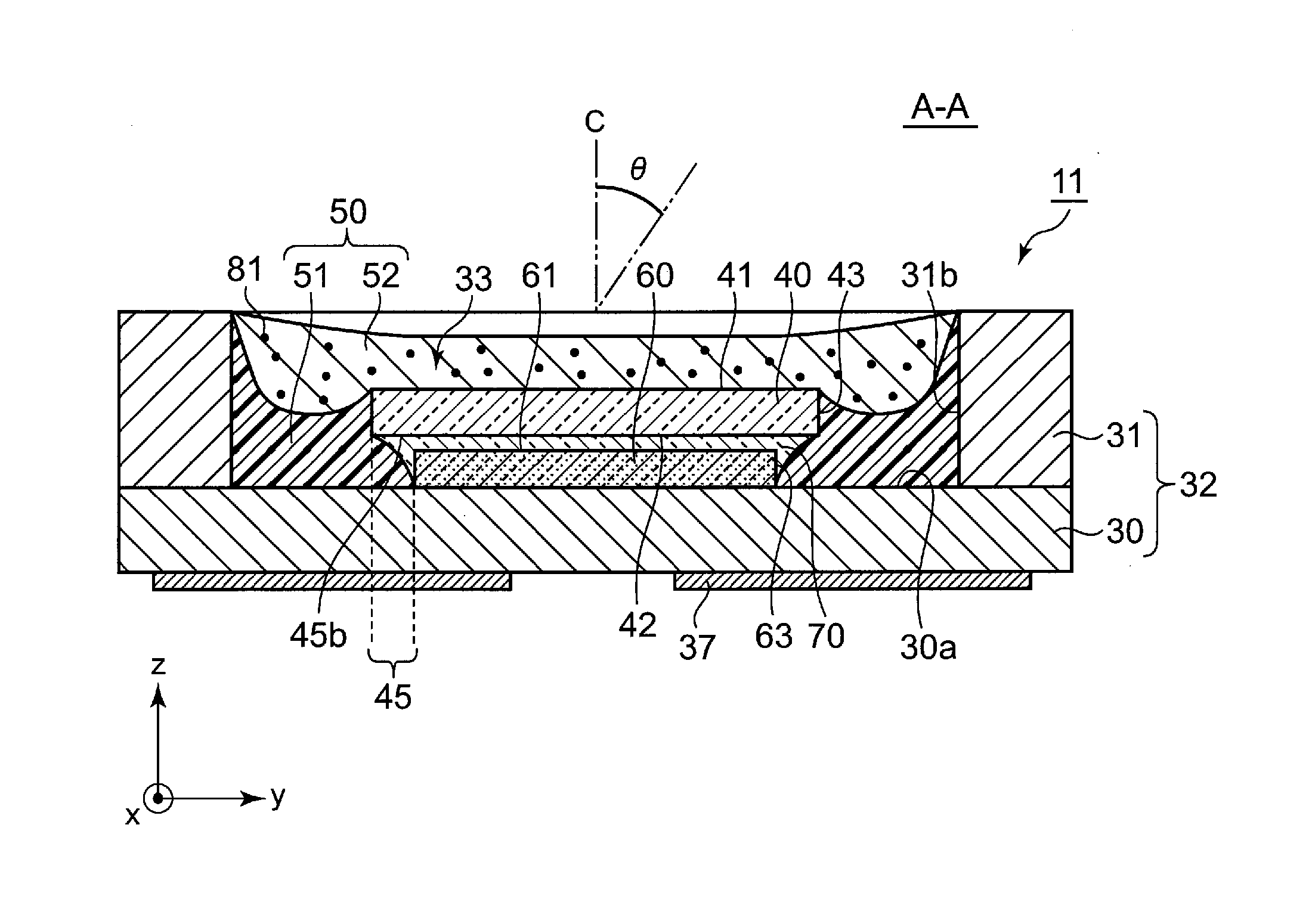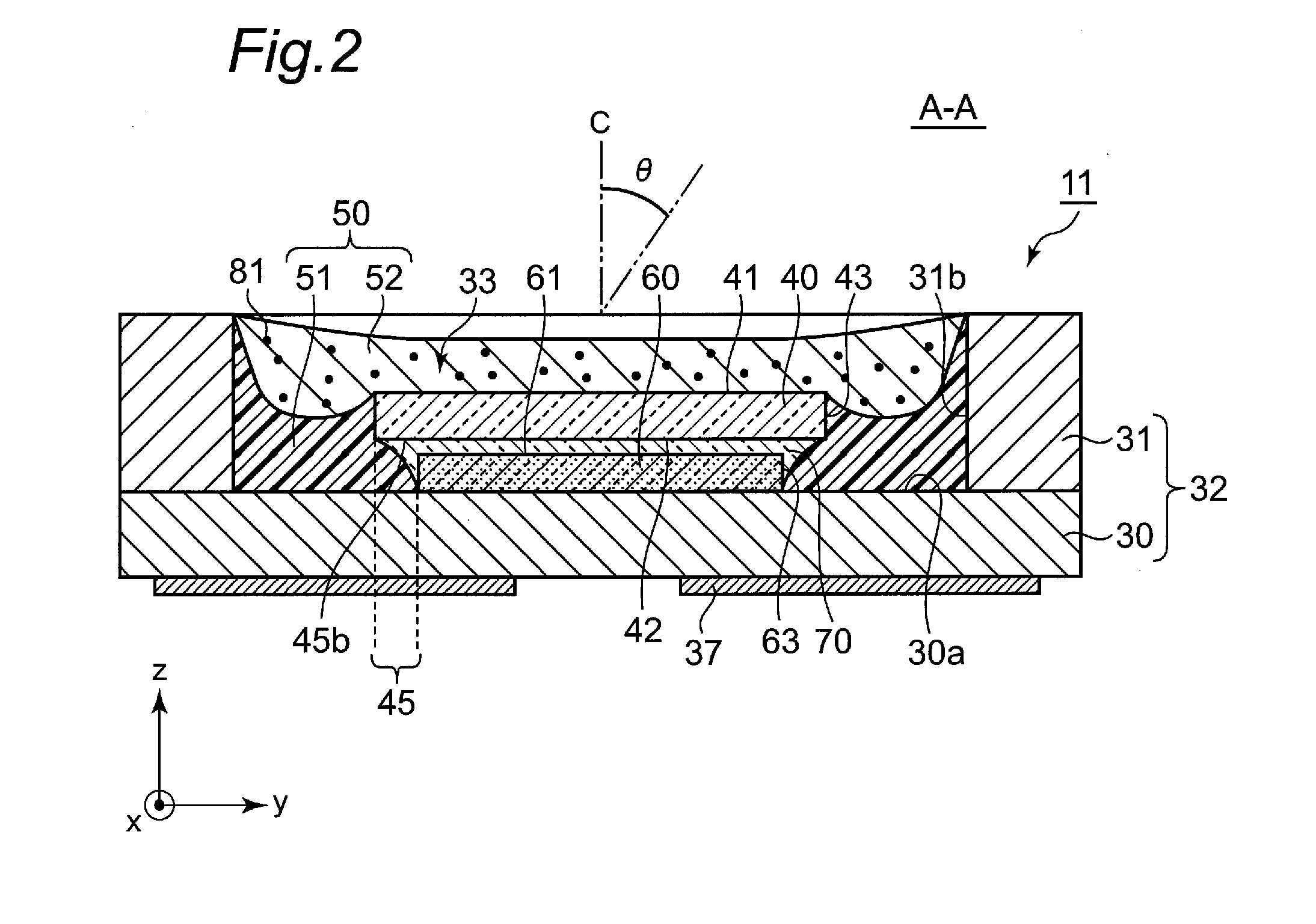Semiconductor light emitting device
a technology of light emitting devices and semiconductors, which is applied in the manufacture of semiconductor/solid-state devices, semiconductor devices, and semiconductor devices. it can solve the problems of insufficient brightness of insufficient expansion of the light transmitting area in such a practically enlarged appearance of the light emitting area, and insufficient light spreading to the edge portion of the light transmitting member. achieve the effect of convenient formation
- Summary
- Abstract
- Description
- Claims
- Application Information
AI Technical Summary
Benefits of technology
Problems solved by technology
Method used
Image
Examples
first embodiment
[0027]As shown in FIG. 1 and FIG. 2, a light emitting device 11 according to the present embodiment includes a housing 32 constituted of a substrate 30 and side walls 31, a light emitting element 60 mounted on an upper surface 30a of the substrate 30 in a recessed portion 33 of the housing 32, and a plate-shaped light transmissive member 40 placed over an upper surface 61 of the light emitting element 60. The light transmissive member 40 and the light emitting element 60 can be bonded by using, for example, pressure bonding, sintering, bonding with adhesive, or bonding with low melting point glass. In the light emitting device 11 according to the present embodiment, the light transmissive member 40 and the light emitting element are fixed with a light transmissive adhesive layer 70. The light emitting element 60 and the light transmissive member 40 in the recessed portion 33 are sealed with a sealing member 50 constituted of two layers. In the present embodiment, different from thos...
second embodiment
[0056]The light emitting device according to the present embodiment is largely different from the light emitting device 11 according to the first embodiment in that the sealing member 50 covering the side surfaces 43 of the light transmissive member 40 is changed from the light reflecting layer 51 to the phosphor-containing layer 52. In addition, the light emitting device according to the present embodiment is different from the light emitting device 11 according to the first embodiment also in that the side surfaces 63 of the light emitting element 60 is directly covered with the light reflecting layer 51. The other configuration is the same as that in the light emitting device 11 according to the first embodiment. Hereinafter, a description will be made on points in which the light emitting device according to the present embodiment is different from the light emitting device 11 according to the first embodiment.
[0057]As shown in FIG. 5, in a light emitting device 12 according to ...
modified example
[0066]FIG. 6 shows a light emitting device 12′ according to the modified example of the present embodiment. In the light emitting device 12′, in a phosphor-containing layer 52, a phosphor 81 is deposited on an upper surface 41 of a light transmissive member 40 and a boundary surface 55 between the phosphor-containing layer 52 and a light reflecting layer 51. However, the phosphor 81 is not deposited on the part under an outer extended part 45, and a phosphor layer 80 has a profile as shown in FIG. 6. Because the phosphor layer 80 does not substantially extend direct under the outer extended part 45, most of emitted light exiting downward from a lower surface 45b of the outer extended part 45 is reflected by the light reflecting layer 51 without colliding with the phosphor layer 80 (in other words, without being scattered by the phosphor 81 in the phosphor layer 80). Here, the upper surface (the boundary surface 55 ) of the light reflecting layer 51 has a cross-sectional shape of a s...
PUM
| Property | Measurement | Unit |
|---|---|---|
| thickness | aaaaa | aaaaa |
| thickness | aaaaa | aaaaa |
| length | aaaaa | aaaaa |
Abstract
Description
Claims
Application Information
 Login to View More
Login to View More - R&D
- Intellectual Property
- Life Sciences
- Materials
- Tech Scout
- Unparalleled Data Quality
- Higher Quality Content
- 60% Fewer Hallucinations
Browse by: Latest US Patents, China's latest patents, Technical Efficacy Thesaurus, Application Domain, Technology Topic, Popular Technical Reports.
© 2025 PatSnap. All rights reserved.Legal|Privacy policy|Modern Slavery Act Transparency Statement|Sitemap|About US| Contact US: help@patsnap.com



